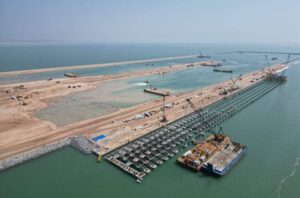Two of Iraq’s most ambitious infrastructure endeavors – the Central Bank Tower in Baghdad and the Grand Al-Faw Port in Basra – have been recognized as leading mega projects globally for 2025. Ranked 11th and 10th respectively by the esteemed British platform The B1M, these projects underscore Iraq’s expanding role in global architecture and infrastructure development.
This recognition not only highlights Iraq’s commitment to modernization but also signals the country’s efforts to reclaim its status as a center for economic growth and cultural advancement.
Zaha Hadid’s Central Bank Tower: A Symbol of Innovation and Iraq’s Tallest Building
Designed by world-renowned Iraqi architect Zaha Hadid, the Central Bank Tower stands as a beacon of modernity in Baghdad’s skyline. Located in the Jadriya district along the Tigris River, the tower is set to become Iraq’s tallest structure upon completion in 2025.
Key Features of the Central Bank Tower:
- Height: 172 meters, making it Iraq’s tallest building.
- Floors: 38, with three underground levels.
- Total Area: 19,000 square meters, housing office and administrative spaces.
Construction began in 2018, and the project reflects Zaha Hadid’s signature futuristic aesthetic, seamlessly blending form with functionality. The tower will serve as the Central Bank’s headquarters, symbolizing both economic resilience and Iraq’s architectural ambitions.
Zaha Hadid’s Legacy Lives On
Zaha Hadid’s contributions to architecture continue to resonate globally, and her impact on her homeland is no exception. The Central Bank Tower embodies her vision of harmonizing striking design with structural innovation, solidifying her enduring influence on contemporary architecture.
Grand Al-Faw Port: Iraq’s Gateway to Global Trade

Ranked 10th by The B1M, the Grand Al-Faw Port is set to revolutionize Iraq’s maritime and trade capabilities. Located at the mouth of the Shatt al-Arab, the port is being constructed by South Korea’s Daewoo Corporation under a $5 billion contract.
Key Features of the Grand Al-Faw Port:
- Area: 54 square kilometers.
- Capacity: Up to 90 shipping berths.
- Breakwater: A 14-kilometer structure, certified by Guinness World Records as the world’s longest.
Built in five phases, the port’s first phase is expected to be operational by late 2025. The project will integrate industrial zones, residential areas, and tourism facilities, cementing its position as a comprehensive economic hub.
Regional and Global Impact of Iraq’s Mega Projects
Both the Central Bank Tower and the Grand Al-Faw Port are pivotal to Iraq’s strategy of economic diversification, reducing reliance on oil revenues. The Grand Al-Faw Port, in particular, will position Iraq as a critical link between Asia, Europe, and the Middle East, bolstering international trade.
The Central Bank Tower, meanwhile, highlights Iraq’s architectural prowess, establishing Baghdad as a center of cutting-edge design and construction.
Driving Economic and Geopolitical Influence
The Grand Al-Faw Port is poised to compete with leading Gulf ports, enhancing Iraq’s geopolitical significance and strengthening its influence in regional trade. Together, these projects reflect Iraq’s aspirations to reclaim leadership in the Middle East.
Key Opportunities and Benefits:
- Economic Diversification: New avenues in trade, tourism, and industry reduce Iraq’s dependence on oil.
- International Collaboration: Partnerships, like Daewoo’s involvement, bring investment and technical expertise.
- National Pride: These achievements elevate Iraq’s global image and inspire further domestic development.
A Vision for the Future
Iraq’s inclusion in The B1M’s top mega projects list is a testament to the country’s resilience and forward-looking vision. The Central Bank Tower and Grand Al-Faw Port not only raise Iraq’s international standing but also pave the way for economic revitalization and cultural resurgence.
As Iraq continues its path to modernization, these transformative projects stand as milestones in the nation’s journey toward reclaiming its place as a beacon of progress and innovation in the Middle East and beyond.























































